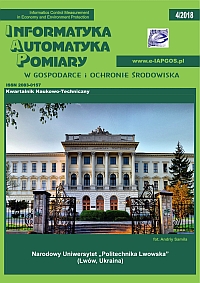METODA BEZPIECZNEGO LĄDOWANIA AWARYJNEGO KWADROKOPTERA
##plugins.themes.bootstrap3.article.sidebar##
Open full text
Numer Tom 8 Nr 4 (2018)
-
ŹRÓDŁA PROMIENIOWANIA W ZAKRESIE KRÓTKOFALOWYM NA PODSTAWIE HETEROWARSTW GRUP II-VI
Mikhail Slyotov, Alexey Slyotov4-7
-
ANALIZA METOD SEPARACJI WIDM OPTYCZNYCH DLA INDYWIDUALNYCH SKŁADNIKÓW
Viktor Makhniy, Oksana Kinzerska, Illia Senko8-11
-
CECHY ZARZĄDZANIA KLUCZAMI SZYFROWANIA DANYCH PRZECHOWYWANYCH W CHMURZE MS SQL AZURE
Olexander Beley12-15
-
WIELOKRYTERIALNY WYBÓR OPTYMALNYCH OPCJI PROJEKTOWYCH DLA TELEKOMUNIKACJI
Valeriy Bezruk, Daria Chebotareva, Yulia Skoryk16-19
-
OPRACOWANIE METODY POŚREDNIEGO STEGANOGRAFICZNEGO UKRYWANIA DANYCH W INFORMACJI O KONTURZE
Volodymyr Barannik, Oleg Shatun, Dmitriy Barannik, Veronika Kobtseva20-23
-
ZASTOSOWANIE METOD STEGANOGRAFICZNYCH DO ATAKÓW W SYSTEMACH INFORMACYJNO-KOMUNIKACYJNYCH
Anna Romanova, Sergiy Toliupa24-27
-
BUDOWA SYSTEMÓW WYKRYWANIA ATAKÓW NA PODSTAWIE METOD INTELIGENTNEJ ANALIZY DANYCH
Serhii Toliupa, Mykola Brailovskyi, Ivan Parkhomenko28-31
-
PRZEGLĄD ZASTOSOWAŃ KONSTRUKCJI Z PRZEWODÓW W URZĄDZENIACH RADIOWYCH
Mykola Khobzei, Dmytro Vovchuk, Magdalena Michalska32-35
-
POPRAWA JAKOŚCI KLASYFIKACJI OBIEKTÓW RUCHOMYCH W SYSTEMACH ALARMOWYCH Z WYKORZYSTANIEM CZUJNIKÓW SEJSMICZNYCH
Bohdan Volochiy, Mykhailo Zmysnyi, Leonid Ozirkovskyy, Volodymyr Onyshchenko, Yuriy Salnyk36-39
-
ALGORYTMICZNE SYSTEMY WSPARCIA BEZZAŁOGOWYCH STATKÓW POWIETRZNYCH I CECHY STRUKTURY POKŁADOWYCH SYSTEMÓW NAWIGACYJNYCH
Mykola Mykyjchuk, Volodymyr Markiv40-43
-
METODA BEZPIECZNEGO LĄDOWANIA AWARYJNEGO KWADROKOPTERA
Bohdan Blagitko, Yuriy Mochulsky44-47
-
POPRAWA METOD KOMPENSACJI RUCHU PORUSZAJĄCYCH SIĘ OBIEKTÓW DYNAMICZNYCH W STREAMIE WIDEO SYSTEMU WIDEOKONFERENCYJNEGO
Volodymyr Barannik, Mykola Dvorsky, Valeriy Barannik, Viktoria Himenko, Anton Sorokun48-51
-
SYSTEM INFORMACYJNY DO OCENY ZŁOŻONOŚCI DZIAŁALNOŚCI ZAWODOWEJ – TEORETYCZNE I PRAKTYCZNE ASPEKTY WDROŻENIA
Oleg Zaritskyi52-55
-
ZJAWISKO INFLUENCJI SŁONECZNYCH W SATELITARNYCH SYSTEMACH GEO W ASPEKCIE PROPAGACJI FAL RADIOWYCH
Jacek Łukasz Wilk-Jakubowski56-59
-
WPŁYW ALGORYTMÓW STEROWANIA ROBOTEM MOBILNYM NA PROCES UNIKANIA PRZESZKÓD
Piotr Wójcicki, Paweł Powroźnik, Kamil Żyła, Stanisław Grzegórski60-63
-
MODYFIKACJE METODY P&O ŚLEDZENIA MAKSYMALNEGO PUNKTU MOCY DLA PANELU FOTOWOLTAICZNEGO
Piotr Kozierski, Adam Owczarkowski, Marcin Lis, Dariusz Horla64-67
Archiwum
-
Tom 10 Nr 4
2020-12-20 16
-
Tom 10 Nr 3
2020-09-30 22
-
Tom 10 Nr 2
2020-06-30 16
-
Tom 10 Nr 1
2020-03-30 19
-
Tom 9 Nr 4
2019-12-16 20
-
Tom 9 Nr 3
2019-09-26 20
-
Tom 9 Nr 2
2019-06-21 16
-
Tom 9 Nr 1
2019-03-03 13
-
Tom 8 Nr 4
2018-12-16 16
-
Tom 8 Nr 3
2018-09-25 16
-
Tom 8 Nr 2
2018-05-30 18
-
Tom 8 Nr 1
2018-02-28 18
-
Tom 7 Nr 4
2017-12-21 23
-
Tom 7 Nr 3
2017-09-30 24
-
Tom 7 Nr 2
2017-06-30 27
-
Tom 7 Nr 1
2017-03-03 33
-
Tom 6 Nr 4
2016-12-22 16
-
Tom 6 Nr 3
2016-08-08 18
-
Tom 6 Nr 2
2016-05-10 16
-
Tom 6 Nr 1
2016-02-04 16
##plugins.themes.bootstrap3.article.main##
DOI
Authors
Abstrakt
Podstawowe cechy awaryjnego lądowania bezzałogowego kwadrokoptera zostały opisane metodami modelowania matematycznego. Zaproponowano metodę bezpiecznego lądowania bezzałogowego kwadrokoptera w przypadku awarii jednego z czterech par silnik-wirnik. Podstawą proponowanej metody jest zastosowanie efektu spadochronu. Efekt spadochronu jest osiągany poprzez przymusowe wyłączenia zasilania silnika elektrycznego, który znajduje się na przeciwległym końcu belki z uszkodzonym silnikiem. W rezultacie prędkość pionowa kwadrokoptera w momencie lądowania znacząco maleje w stosunku do prędkości swobodnego spadania.
Słowa kluczowe:
Bibliografia
Blagitko B., Mochulsky Y.: Emergency landing of quadrocopter in unmanned flight. Electronics and Information Technologies 8/2017, 137–142.
Blagitko B., Mochulsky Y.: Mathematical modeling of quadrocopter stabilization in flight. Electronics and Information Technologies 3/2013, 96–107.
Blagitko B., Zaiachuk I., Kit L., Mochulsky Y.: Modeling of the process of control of vertical take-off and landing of unmanned quadrocopter. Physical-mathematical modeling and information technologies 2/2012, 111–117.
Blagitko B., Zaiachuk I., Mochulsky Y.: Mathematical modeling of the effect of sensor features on the flight process of an unmanned quadrocopter. Physical-mathematical modeling and information technologies 21/2015, 22–29.
Huang H., Hoffmann G. M., Waslander S. L., Tomlin C. J.: Aerodynamics and control of autonomous quadrotor helicopters in aggressive maneuvering. IEEE International Conference on Robotics and Automation, May 2009, 3277–3282.
Marcelo B.,.Sampaio R.C.B, Bounabdallah S., Perrot V., Siegwart R.: In-Flight Collision Avoidance Controller Based Only on OS4 Embedded Sensors. Journal of the Brazilian Society of Mechanical Sciences and Engineering XXXIV(3)/2012, 294–107.
Mochulsky Y.: Matlab In Physical Research: tutor. – method. manual. VTS LNU them. Ivan Franko, Lviv 2004.
Nartin P., Salaun E.: The True Role of Accelerometer Feedback in Quadrotor Control. IEEE International Conference on Robotics and Automation, Anchorage, May 2010, 1623–1629.
Wissiere D., Bristeau P.-J., Martin A., Petit N.: Experimental autonomous flight of a small-scaled helicopter using accurate dynamics model and low-cost sensors. Proceeding of the 17th Word Congress The International Federation of Automatic Control. Seoul Korea 2008, 14642–14650.
##plugins.themes.bootstrap3.article.details##
Abstract views: 367
Licencja

Utwór dostępny jest na licencji Creative Commons Uznanie autorstwa – Na tych samych warunkach 4.0 Miedzynarodowe.






